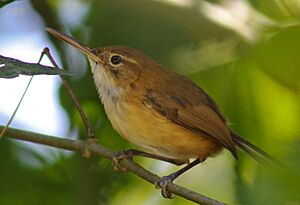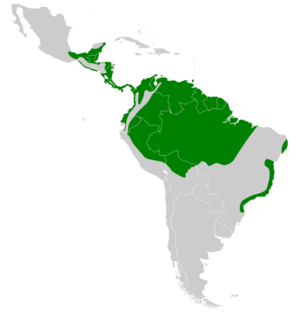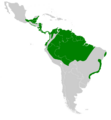Trilling gnatwren facts for kids
Quick facts for kids Trilling gnatwren |
|
|---|---|
 |
|
| Conservation status | |
| Scientific classification | |
| Genus: |
Ramphocaenus
|
| Species: |
melanurus
|
 |
|
The trilling gnatwren (Ramphocaenus melanurus) is a tiny bird that belongs to the gnatcatcher family. It used to be called the long-billed gnatwren. You can find this small bird from southern Mexico all the way down to Ecuador and the Amazonia region.
Contents
About the Trilling Gnatwren
The trilling gnatwren is a very small bird. It measures about 12 to 13 centimeters (around 5 inches) long. It weighs only 8 to 11 grams, which is about as much as two quarters! These birds have a long, thin bill and a short tail that they often hold upright.
Their upper body is grey-brown. The sides of their head have a reddish-brown color. Their throat is white, and the rest of their belly is a pale, yellowish-brown. Their tail is black with white tips on most of the feathers. They often wag their tail back and forth.
What Does It Sound Like?
The trilling gnatwren gets its name from its special call. It makes a fast, trilled sound that goes "drdrdrdrdrdrdrdrdrdr." This unique sound helps people identify them in the forest.
Where Trilling Gnatwrens Live
These little birds live in warm places. You can find them in the thick bushes and climbing plants of dry forests. They also live in areas where forests have grown back after being cut down. Their home range stretches from Mexico south to Peru and Brazil. They also live on the island of Trinidad.
Trilling Gnatwren Behavior
Trilling gnatwrens are active birds. They are always busy looking for food among the plants. They usually move around in pairs or small family groups.
Reproduction and Life Cycle
Trilling gnatwrens are careful about where they build their nests. They make a deep, cup-shaped nest very low to the ground. They often choose a small plant or a young tree.
The female bird lays two white eggs. Both the mother and father bird take turns sitting on the eggs to keep them warm. This is called incubation. The eggs hatch after about 16 to 17 days. After hatching, the baby birds stay in the nest for another 11 to 12 days before they are ready to fly.
What Do Trilling Gnatwrens Eat?
Trilling gnatwrens are insect eaters. They actively search through plants to find their meals. Their diet mainly includes insects, insect eggs, and spiders. They are very good at finding tiny creatures hidden in the leaves and branches.
Images for kids



